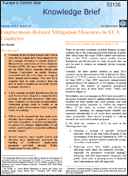Over the past decade the former Soviet zone turned into one of the major human migration regions in the world. The amount of remittances sent home by labor migrants grew significantly in the 2000s and peaked in 2008. Labor migration became a potential major force for integration among the former Soviet republics.
Although Central Asia represents only a fraction of the world’s total migrant population, the region’s economies are heavily influenced by migrant workers. Tajikistan has the world’s highest proportion of remittances to GDP. In 2007 remittances comprised 36% of its GDP, or $1.8 billion, while Kyrgyzstan ranked fourth in the world, with 27% of GDP or $322 million. Some reports estimate that Tajikistan’s remittances make up as much as 46% of its GDP. With that, neither country ranks nearly as high in terms of the volume of remittances received.
Experts estimate there are between 600,000 and over one million Tajik migrants in Russia, who sent more than $1.8 billion as remittances in 2007. This sum is substantial, especially compared with the $400 million in salaries earned by Tajik citizens at home. The Tajik government usually reports some 400,000-500,000 labor migrants residing abroad. But according to World Bank data, roughly 800,000 Tajik migrants – nearly 12% of the total population of Tajikistan – work in Russia, Kazakhstan, Kyrgyzstan and Uzbekistan combined. IOM reports that up to 90% of Tajik migrants work in Russia. Estimates of Kyrgyz migrants vary from 500,000 to over one million. Most official sources cite 600,000 migrants working in Russia, Kazakhstan, Turkey, United States and the Baltic States, which would be 11.7% of Kyrgyzstan’s total population. Kyrgyzstan, Tajikistan and Kazakhstan are also the leading former Soviet states in terms of remittances sent in proportion to their GDPs by labor migrants received by these countries. Over 270,000 Tajiks and Uzbeks travel to Kyrgyzstan for seasonal work, while Tajikistan hosts some 300,000 migrants, mostly refugees from Afghanistan and ethnic Tajiks from Uzbekistan. Labor migrants in Kyrgyzstan send remittances equal to 14% of that country’s GDP abroad, while in Tajikistan the figure is 5%. By comparison, remittances sent from Kazakhstan equal to only 4% of the country’s GDP.
Uzbekistan’s emigrant population is the largest in Central Asia in absolute numbers. Over 2 million immigrants from Uzbekistan reportedly reside in Russia, Kazakhstan, Kyrgyzstan, South Korea, the United States, and Europe. These migrants send over $1.3 billion home in remittances annually, making up to 8% of Uzbekistan’s GDP. The real number of Uzbek migrants and the actual size of remittances is believed to be considerably higher than reported by official sources. Roughly 60% of Uzbek migrants work in Russia, making them one of the major immigrant communities there, alongside Ukrainians, Byelorussians, Kazakhs, and Azerbaijanis.
Of all the Central Asian countries Turkmenistan has the lowest number of emigrants working abroad. Some 250,000 persons in this population are reported to be working in Russia, Kazakhstan, Ukraine, Iran, and the United States. Turkmenistan also hosts 223,000 immigrants from Uzbekistan, Russia, Kazakhstan, and Azerbaijan. Therefore Turkmenistan’s net migration is fairly insignificant.


